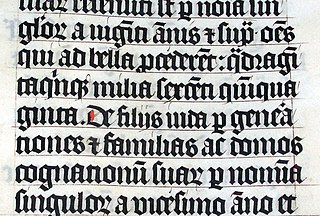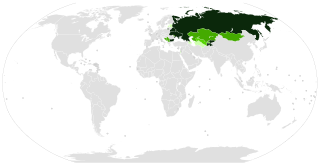
The Latin or Roman alphabet is the writing system originally used by the ancient Romans to write the Latin language.
The Old Hungarian script is an alphabetic writing system used for writing the Hungarian language. Today Hungarian is predominantly written using the Latin-based Hungarian alphabet, but the Old Hungarian script is still in use in some communities. The term "old" refers to the historical priority of the script compared with the Latin-based one. The Old Hungarian script is a child system of the Old Turkic alphabet.
Uyghur is a Turkic language with a long literary tradition spoken in Xinjiang, China by the Uyghurs. Today, the Uyghur Arabic alphabet is the official writing system used for Uyghur in Xinjiang. Whereas other alphabets like the Uyghur Latin alphabet and Uyghur Cyrillic alphabets are still in use outside China, especially Central Asia.
Ezh, also called the "tailed z", is a letter whose lower case form is used in the International Phonetic Alphabet (IPA), representing the voiced postalveolar fricative consonant. For example, the pronunciation of "si" in vision and precision, or the "s" in treasure. See also Ž, the Persian alphabet letter ژ and the Cyrillic ж.

The Early Cyrillic alphabet is a writing system that was developed in the First Bulgarian Empire during the late 9th century on the basis of the Greek alphabet The objective was to make it possible to have Christian service in Slavic tongue, instead of in Greek, which locals did not understand, and to bring Bulgarian subjects closer to the cultural influence of Christianity, the official religion of the Byzantine Empire. It was used by Slavic peoples in South East, Central and Eastern Europe.

The Komi are a Uralic ethnic group whose homeland is in the north-east of European Russia around the basins of the Vychegda, Pechora and Kama rivers. They mostly live in the Komi Republic, Perm Krai, Murmansk Oblast, Khanty–Mansi Autonomous Okrug, and Yamalo-Nenets Autonomous Okrug in the Russian Federation.
Komi-Zyrian language or simply Komi, Zyrian or Zyryan, is one of the two regional varieties of the pluricentric Komi language, the other regional variety being Komi-Permyak.

Dze (Ѕ ѕ) is a letter of the Cyrillic script, used in the Macedonian language to represent the voiced alveolar affricate, pronounced like ⟨ds⟩ in the English word "pods". It is derived from the letter dzelo or zelo of the Early Cyrillic alphabet, and it was used historically for Old Church Slavonic, Ukrainian, Russian, and Romanian.

The Tajik language has been written in three alphabets over the course of its history: an adaptation of the Perso-Arabic script, an adaptation of the Latin script, and an adaptation of the Cyrillic script. Any script used specifically for Tajik may be referred to as the Tajik alphabet, which is written as алифбои тоҷикӣ in Cyrillic characters, الفبای تاجیکی with Arabic script, and alifboji toçikī in Latin script.

Latin or Roman script, is a set of graphic signs (script) based on the letters of the classical Latin alphabet. This is derived from a form of the Cumaean Greek version of the Greek alphabet used by the Etruscans.

Numerous Cyrillic alphabets are based on the Cyrillic script. The early Cyrillic alphabet was developed in the First Bulgarian Empire during the 9th century AD at the Preslav Literary School by Saint Clement of Ohrid and Saint Naum and replaced the earlier Glagolitic script developed by the Byzantine theologians Cyril and Methodius. It is the basis of alphabets used in various languages, past and present, in parts of Southeastern Europe and Northern Eurasia, especially those of Slavic origin, and non-Slavic languages influenced by Russian. As of 2011, around 252 million people in Eurasia use it as the official alphabet for their national languages. About half of them are in Russia. Cyrillic is one of the most-used writing systems in the world.

The Cyrillic Molodtsov alphabet is an alphabet derived from Cyrillic that was used in the 1920s and 1930s to write two versions of the Komi language; Komi-Zyrian and Komi-Permyak. It was replaced by the Latin Molodtsov alphabet in 1931 and later by the Cyrillic alphabet in the Komi Autonomous Soviet Socialist Republic.

A writing system is any conventional method of visually representing verbal communication. While both writing and speech are useful in conveying messages, writing differs in also being a reliable form of information storage and transfer. The processes of encoding and decoding writing systems involve shared understanding between writers and readers of the meaning behind the sets of characters that make up a script. Writing is usually recorded onto a durable medium, such as paper or electronic storage, although non-durable methods may also be used, such as writing on a computer display, on a blackboard, in sand, or by skywriting.

Russian Braille is the braille alphabet of the Russian language. With suitable extensions, it is used for languages of neighboring countries that are written in Cyrillic in print, such as Ukrainian and Mongolian. It is based on the Latin transliteration of Cyrillic, with additional letters assigned idiosyncratically. In Russian, it is known as Шрифт Брайля Shrift Braylya 'Braille Script'.

This article discusses the geographic spread of the Latin script throughout history, from its archaic beginnings in Latium to the dominant writing system on Earth in modernity.




















